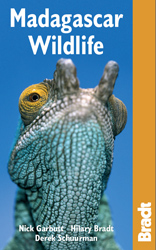 |
|
|
|
|
Travel in Madagascar promises to be an interesting experience. Madagascar's wildlife is among the best in the world in terms of diversity, abundance, and approachability and travel to Madagascar for this purpose is most rewarding. Madagascar also offers spectacular landscapes, an unusual history, and a countryside full of generally friendly and wonderful people.
In planning a trip to Madagascar you are probably best off contacting a professional tour operator who has experience working in the country. While some intrepid travelers have had success simply showing up in the country and figuring it out from there, most Western travelers -- especially Americans -- will have a smoother time if they plan things beforehand. I highly recommend picking up the Bradt Travel Guide to Madagascar to help you make travel decisions and learn about the country.
Some things to do in Madagascar:
WILDLIFE
If you're looking to see wildlife the most accessible reserves are:
| Berenty | Famous for its tame ring-tailed lemurs and sifakas, Berenty is located in the far south of Madagascar. Though touristy and expensive by Madagascar standards, most visitors enjoy the comforts afforded by the Western facilities. Easy access by road following flight to Fort Dauphin. |
| Andasibe-Mantadia | Also known as Perinet, Andasibe-Mantadia is known for the Indri, a lemur that sings songs bizarrely similar to those of a whale. Perinet is roughly 4 hours by on a curvey, but paved highway from the capital city of Tana. Western-style lodgings are available and guides are generally excellent. |
|
Ankarana Montagne d'Ambre |
These two parks are located in the far north of the country. Both offer opportunities for seeing a wide range of reptiles and amphibians, along with several species of lemurs. Ankarana and Montagne d'Ambre can be reached by paved road from Diego Suarez. Overnight facilities are minimal so you should expect to camp. |
|
Kirindy |
Kirindy is an excellent place to see some of the wildlife associated with the dry deciduous forests of western Madagascar including lemurs, the fossa, and the giant jumping rat. Kirindy is accessible on dirt roads from the town on Morondava. Morondava is a brief flight or a long drive from Tana. Facilities are rugged. |
|
Bemaraha |
Most people (though not that many) come to Bemaraha for its limestone tsingy rock formations, but there is an abundance of wildlife in the park including sifakas and red-fronted brown lemurs. Bemaraha is a 4-5 hour drive on sometimes rough roads from Morondava. Facilities are rugged and it can get extremely hot. |
|
Ranomafana |
Ranomafana is one of Madagascar's better known parks due to the discovery of the golden bamboo lemur in 1986. Ranomafana is rich with mammals -- especially lemurs. Ranomafana is accessible by paved road (6-8 hours) from Tana. Facilities are rugged though more Western-style lodgings are in development. |
| Masoala | The Masoala peninsula is Madagascar's most biodiverse region. Even if you don't make it past Nosy Mangabe, a delightful island just 30 minutes by boat from Maroantsetra, you'll still expereince the Malagasy rainforest. Since the habitat is rainforest and there has been hunting in the area, lemurs are a bit more difficult to see than in some of the drier parts of the country, though you'll definitely see Uroplatus geckos and colorful Mantella frogs. Facilities are rugged on the peninsula and Nosy Mangabe only has camping. Maroantsetra is reachable by plane from Tana. Due to its remoteness and catering toward eco-tourists, trips to Masoala are more expensive than other parts of Madagascar |
HIKING and SCENERY
Virtually all of Madagascar's parks feature great hiking. Below are a couple of the notable parks for outdoor adventures.
| Andringitra | Andringitra is one of Madagascar's more accessible mountain parks. Andringitra is characterized by high mountains (peak 2658m), deep valleys, and ridges and sports some of the highest biodiversity in the country. |
|
Ankarana |
Ankarana is known for itself limestone rock formations known as "tsingy." Ankarana also features extensive cave systems which were documented in a National Geographic film. Ankarana can be reached by paved road from Diego Suarez. Expect to camp -- there are no hotels in the park. |
|
Isalo |
Isalo's landscape is comparable to parts of the Grand Canyon. The park consists of eroded ruiniform sandstone formations dating to the Jurassic period, deep canyons with riparian forests, palm-lined oases, fire-resistant tapia forests, and open grasslands. Isalo is an easy 3 hour drive on paved roads from Tulear. Tulear is best reached by airplane. |
|
Bemaraha |
Most people (though not that many) come to Bemaraha for its limestone tsingy rock formations, but there is an abundance of wildlife in the park including sifakas and red-fronted brown lemurs. Bemaraha is a 4-5 hour drive on sometimes rough roads from Morondava. Facilities are rugged and it can get extremely hot. |
CULTURAL ATTRACTIONS
Virtually all of Madagascar's parks feature great hiking. Below are a couple of the notable parks for outdoor adventures.
| Antananarivo | Antananarivo (also called Tananarive or Tana) is the capital city of Madagascar. Located in the highlands of Madagascar, Tana is quite unlike any city you have ever visited before. |
| Andasibe |
BEACHES
Virtually all of Madagascar's parks feature great hiking. Below are a couple of the notable parks for outdoor adventures.
| Nosy Be | Antananarivo (also called Tananarive or Tana) is the capital city of Madagascar. Located in the highlands of Madagascar, Tana is quite unlike any city you have ever visited before. |
| L'Ile Sainte-Marie | L'Ile Sainte-Marie or Nosy Baraha is an island off the eastern coast of Madagascar. Featuring deserted beaches, Sainte-Marie is especially popular for European tourists |
| Nosy Be | Nosy Be is Madagascar's most touristy spot. Cheap holiday-goers flock here for the sun and the beaches. Despite its reputation, Nosy Be does feature a small, but diverse area of forest in the Lokobe Reserve. |
| Ifaty | |
| Masoala | The Masoala peninsula is not only home to rainforest and lemurs; it also sports some of the finest beaches and reefs in Madagascar. |
When is the best time to visit Madagascar?
The best time of the year to visit Madagascar is probably September - November after the cool, dry winter but before the hot rainy season. Cyclone season is February to March when the climate is at its rainiest. Many animals are least active during the coldest months (June-August).
Times of special interest:
- late January - March: cyclone season, peak herp (reptiles and amphibians) season, best time for flowering orchids
- April - May: rains mostly finished leaving the countryside lush and green
- July - August: coolest time of the year, peak whale watching season in the Bay of Antongil (July-Sept), many animals inactive or hibernating
- September - December: excellent time for birding; the breeding season
- October - November: baby lemur season, generally mild weather
Madagascar travel tips
Tour operators in Madagascar
Rainbow Tours
Cortez Travel, Inc.
Madagascar Touring
Natural World Safaris
Find a mistake? Want to submit pictures or content? Contact WildMadagascar.org
|
Home About Madagascar
Wildlife
|
Conservation
Educational Media resources Store Madagascar Travel About the site
Links Contact |
WILDMADAGASCAR.ORG
WildMadagascar.org aims to raise interest in Madagascar, a land of cultural and biological richness
|
Madagascar Madagascar Pictures Newsletter / alerts People of Madagascar |
About the site Educational materials Help Madagascar In French |
|
Follow @wildmadagascar |
SUPPORT
You can help support wildmadagascar.org by using this link to buy from Amazon.com.
 |

| Beautifully illustrated with full color photographs throughout, Madagascar Wildlife is a celebration of the unique fauna of a remarkable island and the perfect accompaniment to Bradt's popular general travel guide, Madagascar. |
|
home | photos index | search | about | contact Unless otherwise noted, all content and images are the property of Rhett Butler, content copyright 2004-2019. All rights reserved. |